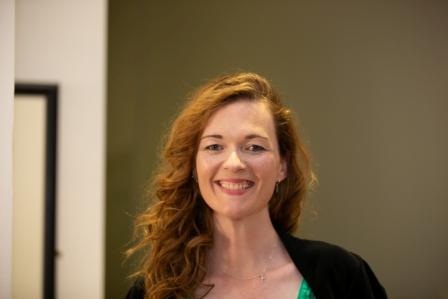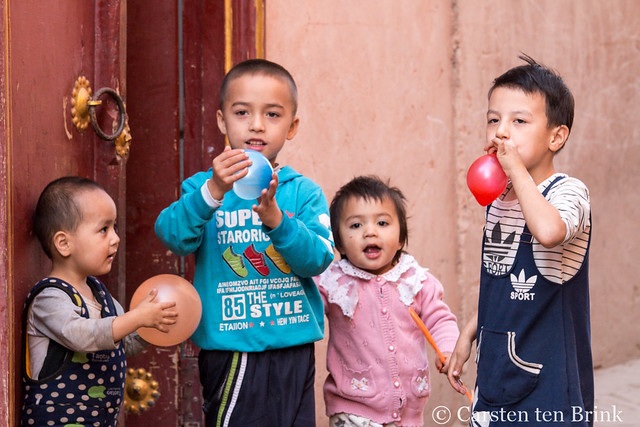Just Published: Post-Apocalyptic Wales, Uyghur Poems, and More
Posted on August 01, 2019

Sometimes I think it's impossible for someone to be as beautiful and ugly as my mother," comments the fourteen-year-old co-narrator of Manon Steffan Ros's award-winning Llyfr Glas Nebo (The Blue Book of Nebo). The novel, translated from the Welsh and excerpted in this month's issue of Words Without Borders, is in the form of dual diary entries from a boy and his mother following a world-ending war.
The boy, Siôn (pronounced like "Sean"), and his mother, Rowenna, take turns writing in a blue notebook, which they found while looting an abandoned house in Nebo, Wales. Nebo, and other places mentioned in the excerpt, may be unfamiliar to student readers. To help them gain familiarity, you might have students find those places on Google (beginning with the link to Nebo above), examine the landscape with Google's Streetview and photographic features, and/or create sketches based on imagery in the excerpt, such as the description of the view from the top of the lean-to:
Down toward Caernarfon, where you can see the castle towers jutting out like gnarling teeth, and then the sea and Anglesey beyond it.
In the introduction to this issue of the magazine, Casi Dylan characterizes Welsh literature as a literature which, often through the bludgeoning of circumstance, has had to deeply consider the politics and poetics of place, of language and memory, of incorporating diversity into a fight for survival. To find out more about the culture and history that informs this novel, students might begin with the multimedia "An Introduction to Wales", also available in basic English for English Language Learners, and published by the Norwegian Digital Learning Arena,
A class discussion might examine the use of a dual perspective in this novel. We get to know Siôn and Rowenna through their own words and through their words about one another. For example, we first encounter Rowenna as Siôn's formidable "Mam," and only afterwards as "Rowenna," who writes in a more tentative voice than we might have expected. To get students thinking about this technique, you might ask:
- What is the difference between calling a character "Mam," as Siôn does, and using her name, "Rowenna?"
- What do these two characters understand about each other?
- What do they not yet understand?
The Blue Book of Nebo would pair well with:
- Other diaries from children's points of view, both fictional (Emma Donahue's Room, about a boy who has been held captive with his mother from birth) and actual (In her Diary, Anne Frank tries to come to terms with her relationship with her mother.)
- Other works depicting apocalyptic or post-apocalyptic worlds, from The Hunger Games to Octavia Butler's Parable of the the Sower to Alexandr Chudakov's A Gloom Is Cast upon the Ancient Steps, which memorializes a community of former prisoners and exiles from Stalin's Soviet Union and is excerpted on this site. (Scholar Julia Trubikhina comments that "in order to survive," Chudakov's characters transform themselves into "Robinson Crusoes." For more of her commentary on this novel as post-apocalyptic fiction, see the Context tab for the excerpt.)
Potential assignments or projects following a reading of the excerpt might include:
- Writing a chapter from the point of view of Siôn's younger sister, Dwynwen
- Writing a dialogue between a character from The Blue Book and a character in a one of the works above. For example, Siôn or Rowenna would have an interesting conversation with Lauren, the teen narrator of the Parable of the the Sower.
- Writing an essay about the strengths and limitations of either Sion or Rowenna's points of view
- Writing and performing a story told through alternating viewpoints (students might work in pairs.)
For more resources and a link to the full-length novel, now available in English, visit our 2021 blog post: In Wales, a "Blue Book" helps a mother and son cope with an apocalypse.
Poetry from a "Rapidly Disappearing" World

This month, Words Without Borders is also publishing poetry written by Muslim, Christian, and Buddhist writers from China, along with audio and original-language text. One of the authors is Tahir Hamut, an ethnic Uyghur (pronounced we-ger) poet and filmmaker who is living in exile in Washington, D.C. following the Chinese government's large-scale repressions of Uyghur Muslims. Those repressions have included the imprisonment of more than a million people in "re-education centers," for such supposed crimes as having beards or Muslim names.
It is sometimes difficult for students to connect to global issues of such magnitude, especially at a geographical or cultural remove. Tahir Hamut's poems, with their immediate emotional resonance, help bridge this distance. Students may well be able to identify with the longing in Hamut's "Phone Call":
A phone call makes the heart tremble
a beautiful woman tosses and turns
In her mind she kisses the voice
In her mind she sees the daybreak
They can listen to the poem in the original Uyghur below and on SoundCloud.
As a creative response, students might write their own poems about waiting, whether for a particular person, an event, or a change in their lives.
For more poetry from Hamut, classes can then read "A Night Sama," which connects contemporary poetry with traditional dance. The Mazateco Mexican poet Juan Gregorio Regino makes a similar connection between tradition and modernity in his poem "Nothing Remains Empty" (in the form of a Mazateco chant); as does the Silver Age Russian poet Marina Tsvetaeva in her folkloric "To kiss a forehead is to erase worry." Reading those poems in conjunction with Hamut's will help students understand his work as part of a global conversation about the role of poetry in the modern era: should poetry push art into new directions, safeguard traditional forms of expression, or somehow do both?
Uyghur Culture and History
Introducing the poetry in this issue, guest editor Eleanor Goodman notes that:
In his poetry, Hamut gives voice not only to his own religious experience, but also to a people who cannot at the moment speak openly for themselves. He writes from a perspective that may soon be lost to the world, as the place in which he grew is rapidly disappearing.
To begin to learn about this world, students can watch a three-minute video featuring young Uyghur people teaching about the culture at a festival in Australia; or read dated but still useful resources from everyculture.com.
To find out about efforts to preserve Uyghur culture outside of China, including a seventeen-year-old's collection of short stories, students can read "The Future of the Fight to Preserve Uyghur Culture," available from The China Project. If you teach English Language Learners or other students who would benefit from high-interest, simple-English content, the Voice of America Learning English program has a similar story, as well as an archive of other stories, short videos, and audio about Uyghurs.
Tahir Hamut's own efforts to preserve Uyghur culture go beyond poetry. In 2018, he gave a speech about Chinese repressions of Uyghurs to U.S State Department International Ministerial to Advance Religious Freedom, stating that "China has turned the Uyghur region into a police state, an open prison."
Darren Byler, one of Hamut's translators for Words Without Borders, is also active as an advocate for Uyghur rights and reporter on the current crisis. To learn more about how a translator can play these roles, students might take a look at Byler's Twitter feed or YouTube page, or read "Love and Fear Among Rural Uyghur Youth During the People's War," an article he co-authored with Eleanor Moseman.
To reflect on the interplay of history, repression, and culture, students might read Hamut's poetry in conjunction with other writing about "taboo topics" in China, particularly Liao Yiwu's powerful accounting of state crimes against human rights: "This Country Must Break Apart"; or with other writing about humanity amidst repression, such as Svetlana Alexeivich's oral history "The Wondrous Deer of the Eternal Hunt."



